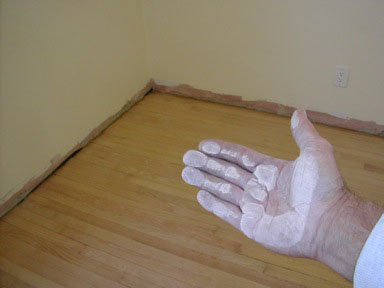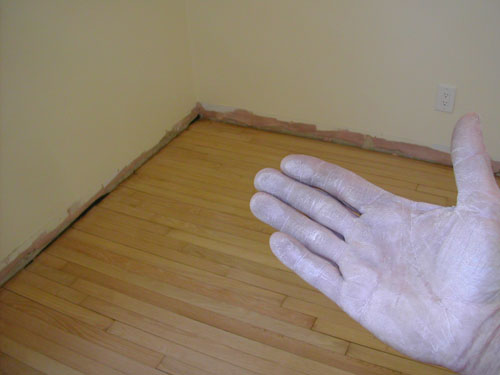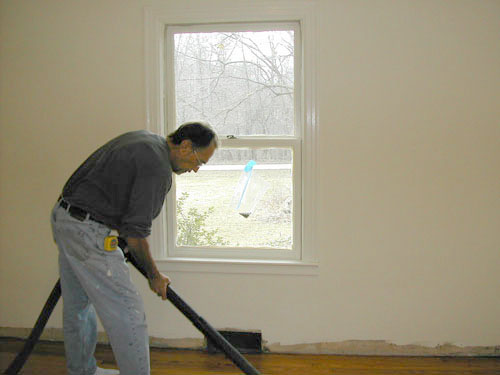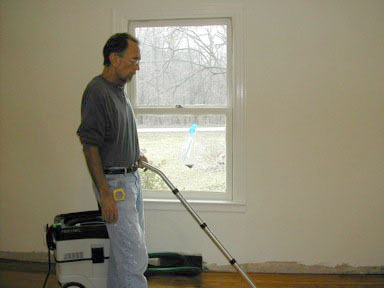
 by Steven D. Johnson
by Steven D. Johnson
Racine, Wisconsin
This month:
•
Festool CT 36 Dust Extractor - More Impressions
•
Measuring & Marking
•
Stairs & Dovetails
•
Make Your Own "Go-Bag"
•
Building Codes - A Brief Primer
Festool CT 36 Dust Extractor - More Testing, More Impressions
When I ordered the
Festool CT 36 Dust Extractor
and two
Festool Sanders
, it was with the justification
and anticipation of "dustless" refinishing of wooden floors, sanding cabinets, doors and windows,
and miles of trim. If you insist on referring to the Dust Extractor as a "shop vacuum" as many of
my friends do, this purchase would be about my tenth (since most shop vacuums are limited-life,
virtually disposable units) and would be my third unit still in operation.
Not necessarily by design, my tools fall into three classifications. The old off/store-brand
plastic handled chisels that stay in the bottom of my
"go-bag"
tool bag
are used sometimes in some rougher home repair jobs, deck building, or, recently,
to free up a sticking gate on a wooden fence. These chisels are what I refer to as "third tier"
tools.
My mid-price mid-line quality chisels often find use in the shop, or at a neighbor's house,
typically doing something that requires a bit of an edge and a bit of finesse. These are "second
tier" tools, and will take an edge, hold it for a while, and may even comfortably and efficiently do
some pretty fine work. Generally these second tier tools will never see double duty as an
improvised screwdriver or paint can lid opener.
Then there are the "tier one" top-of-the line
Lie-Nielsen
and
Japanese Chisels
that will take the
keenest of edges, are machined to near-perfection, feel good in the hand and in use, and will last
much longer than me. I use these first tier tools only for dovetails, mortises, trimming, and other
furniture building activities. These tools never leave the shop, and they are cared for like
kin.
Other tools can be thus categorized as well. I have five electric drills. Three are battery
powered. One is a big tough brut and does big tough brutish jobs. Another is quite adept at
drilling clean straight holes, and another is my favorite for driving screws. Two plug-in hand
drills fall into wildly different categories. One stays in the shop, but in a cabinet, fairly
hidden and hard to access. That's okay, because the last time I used it was to drill the dog holes
in my workbench. It is a fine drill, but who needs a cord these days? The other plug-in drill
stays in a big box with all my drywall tools. For some reason, the poor guy was designated as a
tier three tool and relegated to the mixing of sheet rock mud. It probably is not usable for
anything else now.
Along these lines, I sort of had a "plan" for my new Festool Dust Extractor. The old shop vacuum
in the basement would be used at the "unhandy" house for gross cleanup – a tier 3 job, for sure.
Vacuuming the dust, dirt, and detritus from demolition would be its delegation – the residue of
remodeling. My better ShopVac brand vacuum with a fine particulate filter bag would be used for
removing dust left by the floor sander and for final cleanup after each project was done. The brand
new Festool would be reserved for dust extraction while sanding and for vacuuming only "clean dirt."
Most of my shop hound friends know what I mean by "clean dirt."
After four days of sanding the oak floors level and to bare wood, I used my "tier two" shop
vacuum to remove the last of the dust from the floor prior to finishing. I vacuumed once with the
wood grain, again across the boards, and then a third time with the run of the boards. By this
time, the floor was looking pretty good except for the corners and around door casings and other
"sensitive" areas where I was cautious not to run the floor sander too close.

|
Figure 1 - After three passes with my
shop vacuum, the floor was still dusty
|
Cleaning up those areas was a challenge. There was paint on the floor where previous paint jobs
had been done less than carefully. Chronologically, there was white, blue, green, yellow, and
finally a shade of pink, probably rose, paint at the oldest level. All of this was scraped away
with a razor knife, a dentist's pick, and a riffler file. After that, I used the
Festool DTS 400 Sander
to
get the wood to match the rest of the floor. Working on my hands and knees, up close and personal,
I noticed that even after all the previous vacuuming, there was still dust in the grain of the wood
and between the boards. The DTS 400 sander connected to the CT 36 was sanding and removing
its own sanding dust, as expected, but it was also picking up all the dust left behind by my
previous three, what I thought were very thorough, vacuuming jobs. Out of curiosity, I walked out
into the middle of the room and swiped my hand across the floor. It was covered with dust. Had my
tier two shop vacuum done anything?

|
Figure 2 - After just one pass with the Festool,
the floor was almost perfectly clean
|
I grabbed the
Installer's
cleaning accessory kit
I purchased with the CT 36, connected the tubes and the hose, and went
over the floor...once. Another wipe of the hand showed almost no dust left. I have learned many
lessons in the "unhandy" house, but this will be my most important "teachable moment." The results
of even a "tier two" job will be better when done with a "tier one" tool. In other words, I was
making my life more difficult by "saving" a top tier tool for more delicate work.
In a previous article wherein we looked at
the future of
woodworking
, we discussed tool design
and manufacturing, and the perceived need by manufacturers to hit a certain price point, and how the
trade-offs in quality and usability to hit that price point might discourage new woodworkers. I am
now convinced that the design of mass-market shop vacuums is the poster-child for price/quality
trade-offs that have gone too far...way too far.

|
Figure 3 - Back-breaking two-handed work
with a shop vacuum
|
Everything must factor into price, so I am sure that the length of the plastic tubes that attach
to the end of a shop vacuum hose is at least partly dictated by the size of the box and thus the
cost of shipping. It doesn't matter. After stooping over for a couple of hours vacuuming the
floors, I would have gladly paid a few dollars more for a longer plastic pipe.
I'm sure in contemporary shop vacuum design the hose must cost a few cents per foot, so trimming
the length obviously reduces cost. But the shorter hose means moving the shop vacuum more often.
Annoying, but workable, were it not for the few cents the manufacturer saved by incorporating flimsy
undersized wheels. The wheels on a shop vacuum are not even large enough for the vacuum to roll
over its own power cord. Which, by the way, is too short, too.

|
Figure 4 - Upright, one-handed, and comfortable
with the Festool dust extractor
|
During the floor sanding and finishing process, I had the heat turned off. No reason to suck
dust into the furnace or redistribute it throughout the house any more than necessary. But in the
evenings the inside temperature dropped into the mid-forties. Every few seconds with the shop
vacuum, with an already aching back, frustrated by the inability of the machine to roll, unplugging
and re-plugging every few feet, and listening to the jet-engine-roar of the thing, I was also
getting a pretty good static electric shock.
Vacuuming with the Festool was as pleasurable as vacuuming can be. A long and substantial power
cord is a blessing. The wheels roll gently and reliably over any obstruction, and the CT 36 rolls
where you pull it. No static shocks, thanks to the antistatic hose. The stainless steel wand (tube)
adjusts in length allowing comfortable work regardless of your height. The unit is quiet, and the
exhausted air comes out in a dispersed pattern that does not re-stir the air and blow dust
around.
After vacuuming for a while longer, I realized that I had made a mistake by not using the Festool
for every job in the "unhandy" house...tier one, two, or three. I carried the old shop vacuum to the
basement (I was tempted to launch it down the stairs as a final durability test), and perhaps will
use it to suck up a spill someday. I rather doubt it, though. Some tools are built to be used, not
coddled, and the Festool is a surefire example.
In my writing, particularly product reviews, I try to be fair. I try to look at things from
several angles and different perspectives. In writing any review I zealously avoid commercialism
and bias in hopes that my credibility with you will be untarnished. I am proud to say that Highland
Woodworking has never once questioned my writing about products, good or bad, and has never flinched
when I write positively about products they do not sell or negatively about a product they do sell.
So please, do not lightly assess my recommendation or mistake it for fealty to this Newsletter.
In summary, go to your computer right now, pull up the Highland Woodworking web site, and
order a Festool
dust extractor
. As the "swoosh" people say, "Just do it."
(Page 1 of 5)
1
2
3
4
5
Next Page
Return to
Wood News
front page
